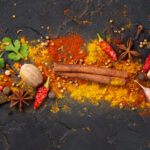
SOME MIND-BOGGING FACTS ABOUT SPICES AND HERBS!
Spices are strong aromatic substances that impart a rich flavour and aroma. They are derived from the roots, bark, or seeds of the plant; for example, turmeric is the underground stem of the Curcuma longa plant, and cinnamon is derived from the bark of evergreen trees.
Spices are used in whole, dried, powdered, or blended form to season cuisines and send a rush of epiphanies into the mouth. However, in ancient times, the word "SPICE" was highly lionized, which led to colonization and the waging of wars across the world.
Vasco da Gama was the first to come to India in 1498 in search of spices. Thereafter, followed by the English, Danes, and French all sailing towards India in the name of the "spice trade."
Apart from flavouring the varied cuisine, it was also extensively used to carry out various rituals and, surprisingly, also for mummification. The spices have had a copious presence in Egypt, China, Greece, and India since time immemorial.
Apart from being ladened with many health-enhancing properties like antioxidant, anti-inflammatory, anti-bacterial, anti-viral, anti-cancer, etc., you will be surprised to uncover some astonishing facts about them :
CUMIN : Cumin dates back to the 1st century BC. Believed to be pious, it was used in the mummification process for its preservation. In ancient folklore, it was believed to be a gift of faithfulness and retention, along with a medium to pay taxes.
CORIANDER : Coriander dates back to 1550 BCE. It was even mentioned in the Bible. The word coriander is derived from the Greek word koris, which is the word for stink bug, because of the similarity of the stench that the stale coriander leaves give off.
BLACK PEPPER : In the 15th century, the world referred to this spice as "black gold." The Portuguese, French, and English reached India in the 15th and 16th centuries in search of this spice to carry out the profitable trade of black pepper. It was also used as a currency in Europe.
BAY LEAF : Bay Leaf has an association with music, as the Tonewood of the California Bay Leaf plant is very much sought after by the makers of violins and guitars. It is also a very good pest and bug repellent.
RED CHILLI : Chilli is a fruit, not a vegetable, and has been cultivated for the last 6000 years. Its spiciness only affects mammals, as birds, slugs, and other animals are entirely immune to its spiciness, which helps them pollinate.
TURMERIC : Buddhist monks were forbidden to wear white, so their attire was dyed in turmeric to impart an orange-yellow hue. Erode in Tamil Nadu is known as Turmeric City, and Somvati Utsav is the Turmeric Festival celebrated in Jejuri, India.
NUTMEG : The nutmeg tree was introduced to India by the British EIC. At one time, it was more expensive than gold due to its rarity and the fact that it took around five to eight years to grow.
GINGER : Ginger is actually a rhizome, not a root. Queen Elizabeth I of England is credited with inventing the delicacy gingerbread man, which is widely savoured on Christmas Eve.
CLOVES : The first mention of the clove is found in the Chinese literature of the Han period during the 3rd century BCE. During the 17th and 18th centuries, cloves were worth their weight in gold due to the exorbitant price paid to import them.
KALONJI : Kalonji has had very prominent fame since the ancient medicinal eras like Unani and Tibb, Ayurveda, and Siddha. It is said by Prophet Mohammad that "Black seeds can heal every disease except death."
ISN’T THIS SOMETHING ?
Recent Posts
rkigroup24
THE INTERTWINED MEDLEY OF INDIAN TASTE
rkigroup24
THE EXHILARATING MASALA DABBA
+0123 (456) 7899
contact@example.com




